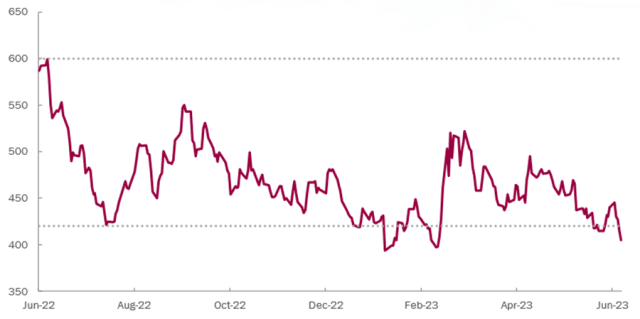High Valuations In The Stock Market: BofA's Rationale For Investor Calm

Table of Contents
BofA's Key Arguments for Maintaining a Positive Market Outlook Despite High Valuations
BofA's core argument centers on a belief that several key factors outweigh the concerns associated with high valuations in the stock market. They suggest that current valuations are justifiable given the current economic landscape and projected growth. Their positive market outlook rests on several pillars:
-
Strong Corporate Earnings Growth Projections: BofA forecasts robust earnings growth for many sectors, driven by factors such as continued digital transformation, increasing consumer spending, and global economic recovery. This projected growth, they argue, can support higher stock prices, even at current valuations.
-
Low Interest Rate Environment: The prevailing low-interest-rate environment, or at least the expectation that rates will remain relatively low for the foreseeable future, reduces the cost of borrowing for corporations and stimulates investment. This, in turn, supports higher valuations and encourages further market growth.
-
Continued Investor Confidence: While volatility exists, several indicators suggest that overall investor confidence remains relatively high. This is evidenced by continued strong inflows into equity markets and consistent participation from both institutional and retail investors. Factors such as the success of the vaccine rollout and government stimulus packages have contributed to this sentiment.
-
Technological Advancements Driving Growth: BofA emphasizes the ongoing technological revolution as a key driver of future earnings growth. Companies leveraging AI, cloud computing, and other advancements are expected to significantly outperform, offsetting concerns about overall market valuations.
-
Specific Sectors Poised for Growth: BofA identifies specific sectors, such as technology, healthcare, and select consumer discretionary areas, as particularly well-positioned for growth despite the overall high stock market valuation. These sectors are seen as having strong long-term growth potential, underpinning their relatively higher valuations.
Analyzing the Metrics: Are Valuations Really Too High?
Assessing whether current valuations are truly "too high" requires a careful examination of various metrics. BofA uses a multifaceted approach, employing multiple valuation ratios to avoid relying on a single indicator. They analyze metrics such as the Price-to-Earnings ratio (P/E), the cyclically adjusted price-to-earnings ratio (Shiller P/E), and other forward-looking measures.
While acknowledging that some metrics suggest high valuations compared to historical averages, BofA points to several crucial nuances:
-
Contextual Differences: BofA emphasizes that simply comparing current valuations to historical averages without accounting for the unique circumstances of the current economic environment (e.g., historically low interest rates, technological disruption) can be misleading.
-
Adjustments for Specific Factors: The firm acknowledges the impact of factors like inflation and low interest rates on valuation metrics and adjusts their analysis accordingly, offering a more nuanced interpretation of the data.
-
Alternative Valuation Metrics: BofA incorporates alternative valuation metrics that paint a less alarming picture, emphasizing the importance of considering various perspectives to form a complete picture of the market's valuation.
The Role of Inflation and Interest Rates in Shaping BofA's Perspective
Inflation and interest rates play crucial roles in shaping BofA's perspective on stock market valuations. The firm's forecasts for these key macroeconomic indicators directly influence their valuation assessments.
-
Inflation and Interest Rate Predictions: BofA's analysts have outlined their predictions for inflation and interest rate movements over the coming periods, factoring these into their valuation models.
-
Influence on Valuation Assessments: These predictions directly impact how BofA interprets valuation metrics. For example, higher-than-expected inflation could negatively impact valuations, while sustained low interest rates could support higher valuations.
-
Sector-Specific Impact: The potential impact of interest rate and inflation changes will vary significantly across different sectors. Some sectors are more sensitive to interest rate fluctuations than others.
Risks and Potential Downside: BofA's Cautions
While BofA maintains a cautiously optimistic outlook, the firm acknowledges several significant risks that could negatively impact the market and invalidate their positive assessment. It's crucial to recognize these potential downsides:
-
Geopolitical Risks: Geopolitical instability, trade wars, and international conflicts can significantly impact investor sentiment and lead to market corrections, regardless of underlying valuations.
-
Economic Shocks and Downturns: Unexpected economic downturns, recessions, or other macroeconomic shocks could trigger significant market declines, irrespective of current valuations.
-
Sector-Specific Risks: Risks associated with specific sectors or individual companies can also impact overall market performance, even in an otherwise robust economic environment.
Conclusion: Navigating High Valuations in the Stock Market – A Balanced Approach
BofA's analysis suggests that while high valuations in the stock market are present, a number of factors – including strong earnings growth projections, a low-interest-rate environment, continued investor confidence, and ongoing technological advancements – support a cautiously optimistic outlook. However, it's crucial to acknowledge the potential downsides and risks. Understanding high valuations in the stock market is crucial for informed investing. Before making any investment decisions based on this information, conduct your own thorough research and consult with a qualified financial professional. For further details, consider reviewing BofA's full report [link to BofA report here].

Featured Posts
-
 Ecb Lingering Pandemic Fiscal Support Fuels Inflation
Apr 29, 2025
Ecb Lingering Pandemic Fiscal Support Fuels Inflation
Apr 29, 2025 -
 Review Porsches New Macan Electric Drive And Its Features
Apr 29, 2025
Review Porsches New Macan Electric Drive And Its Features
Apr 29, 2025 -
 Arizona Boating Competition Speedboat Flips During Record Attempt
Apr 29, 2025
Arizona Boating Competition Speedboat Flips During Record Attempt
Apr 29, 2025 -
 Car Plows Into Crowd At Vancouver Filipino Festival Leaving Nine Dead
Apr 29, 2025
Car Plows Into Crowd At Vancouver Filipino Festival Leaving Nine Dead
Apr 29, 2025 -
 Fox News Faces Defamation Lawsuit From Ray Epps Over January 6th Reporting
Apr 29, 2025
Fox News Faces Defamation Lawsuit From Ray Epps Over January 6th Reporting
Apr 29, 2025
Latest Posts
-
 Senegal Gabon Madagascar And Beyond Pw Cs Departure From Africa
Apr 29, 2025
Senegal Gabon Madagascar And Beyond Pw Cs Departure From Africa
Apr 29, 2025 -
 Bundesligas Italian Impact Grifo Immobile Toni Barzagli And Rizzitellis Success Stories
Apr 29, 2025
Bundesligas Italian Impact Grifo Immobile Toni Barzagli And Rizzitellis Success Stories
Apr 29, 2025 -
 Bundesliga News Lask Und Klagenfurt Kaempfen Mit Schwierigkeiten
Apr 29, 2025
Bundesliga News Lask Und Klagenfurt Kaempfen Mit Schwierigkeiten
Apr 29, 2025 -
 Pw Cs Exit From Nine African Countries Impact And Analysis
Apr 29, 2025
Pw Cs Exit From Nine African Countries Impact And Analysis
Apr 29, 2025 -
 Pw Cs African Retreat Exit From Senegal Gabon Madagascar And More
Apr 29, 2025
Pw Cs African Retreat Exit From Senegal Gabon Madagascar And More
Apr 29, 2025
